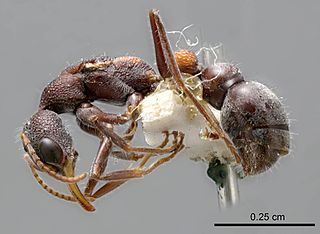Jack jumper ant , Myrmecia pilosula, an Australian ant
Jack jumper ant (also known as jumping jack) can also refer to several other species in the same genus:
- Myrmecia fulvipes
- Myrmecia nigrocincta
- Taxa in the Myrmecia pilosula species complex:
Jack jumper ant , Myrmecia pilosula, an Australian ant
Jack jumper ant (also known as jumping jack) can also refer to several other species in the same genus:

Myrmecia is a genus of ants first established by Danish zoologist Johan Christian Fabricius in 1804. The genus is a member of the subfamily Myrmeciinae of the family Formicidae. Myrmecia is a large genus of ants, comprising at least 93 species that are found throughout Australia and its coastal islands, while a single species is only known from New Caledonia. One species has been introduced out of its natural distribution and was found in New Zealand in 1940, but the ant was last seen in 1981. These ants are commonly known as bull ants, bulldog ants or jack jumper ants, and are also associated with many other common names. They are characterized by their extreme aggressiveness, ferocity, and painful stings. Some species are known for the jumping behavior they exhibit when agitated.

The jack jumper ant, also known as the jack jumper, jumping jack, hopper ant, or jumper ant, is a species of venomous ant native to Australia. Most frequently found in Tasmania and southeast mainland Australia, it is a member of the genus Myrmecia, subfamily Myrmeciinae, and was formally described and named by British entomologist Frederick Smith in 1858. This species is known for its ability to jump long distances. These ants are large; workers and males are about the same size: 12 to 14 mm for workers, and 11 to 12 mm for males. The queen measures roughly 14 to 16 mm long and is similar in appearance to workers, whereas males are identifiable by their perceptibly smaller mandibles.
The Tasmanian Rugby Union, or TRU, is the governing body for the sport of rugby union within the state of Tasmania in Australia. The TRU was established in 1933. It is a member and founding union of Rugby Australia.

Myrmecia esuriens, also known as Tasmanian inchman, is a species of bulldog ant native to Tasmania.
Myrmecia croslandi is a species of bull ant which is endemic to Australia. Myrmecia croslandi is a jumping type of bull ant, which means it could be called a jack jumper. Myrmecia croslandi are located around Australia. They can be seen throughout New South Wales and Queensland. Myrmecia croslandi was described by Taylor in 1991.
Myrmecia pavida is a bull ant species that lives in and is native to Australia. Described by John S. Clark in 1951, the Myrmecia Pavida is distributed and has been mainly collected from the states of Western Australia and South Australia.

Myrmecia loweryi is a species of the giant bull ant which is abundant to Australia. Myrmecia loweryi is one of the latest species of bull ant to be described, which was back in 1991 by Ogata & Taylor. They are mostly located around New South Wales and the Australian Capital Territory.

Myrmecia nigrocincta, commonly known as the jumper ant or jumping jack, is an ant of the genus Myrmecia. The species was first described by Frederick Smith in 1858. Colonies of this ant are abundant in eastern Australia. Ants of this species are known for their ability to jump up to 10 centimetres, and they also have a powerful, venomous sting. Rather than foraging on the ground, M. nigrocincta prefer to forage in trees where they are known to pollinate certain flowers.

Myrmecia fulvipes is a bull ant belonging the genus Myrmecia. Native to Australia, these bull ants are found in Tasmania, Victoria, New South Wales, and Queensland.

Myrmecia browningi is an Australian bull ant species, a part of the genus Myrmecia. They are endemic to Australia and have primarily only been seen in South Australia.

Myrmecia dichospila is an Australian ant which belongs to the genus Myrmecia. This species is endemic to Australia and is heavily distributed in South Australia and have some presence in other several states.

Myrmecia piliventris, the golden tail bull ant, is an Australian ant which belongs to the genus Myrmecia. This species is native to Australia. The Myrmecia piliventris is distributed Australia wide, but they're not too common in the western regions of Australia.

Myrmecia erecta is an Australian bull ant species, a part of the genus Myrmecia. They are endemic to Australia. They are mainly distributed in South Australia and the surrounding areas of the state.

Myrmecia michaelseni is an Australian ant which belongs to the genus Myrmecia. This species is native to Australia. They are mostly distributed and studied in Western Australia.
Myrmecia banksi is a species of ant in the genus Myrmecia. Described by Robert Taylor in 2015, the species is endemic to Australia in New South Wales, where it is normally found on low elevations along coastal regions.
Myrmecia haskinsorum is a species of ant in the genus Myrmecia. Described by Robert Taylor in 2015, the species is endemic to Australia where it is known from areas that have high elevations, although some records show the ant lives in low elevated areas in Tasmania
Myrmecia imaii is a species of ant in the genus Myrmecia. Described by Robert Taylor in 2015, the species is endemic to Australia in Western Australia, particularly in very south-western areas.
Myrmecia impaternata is a species of gynogenetic, female-only ant in the genus Myrmecia. Described by Robert Taylor in 2015, the species is endemic to Australia and is common in Canberra and around Armidale. Observations of the species have been confirmed in Queensland.

Ptilocnemus lemur is a species of feather-legged bug in the family Reduviidae native to Australia. Commonly known as the feather-legged assassin bug, it is a predator with a specialized gland called a trichome that it uses to attract and paralyse ants before feeding on them.